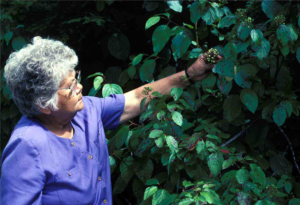Red-osier Dogwood or “Red Willow”
Berries: cpeqpeqeqen’ceni;
Bush: tseqwtsqweqwel’qw te q’wlsellp
The whitish, clustered berries, though tart and bitter, were often eaten by the Secwepemc and were considered an excellent breath freshener. Red willow had a number of important roles in catching and processing fish. The branches were used to make fish weirs and fish traps, for constructing sweat lodges and to surround food in cooking pits. The bark was used to make poultices to relieve pain, swelling, bruising and toothache. It prefers moist, rich soils but will grow in most areas that have sufficient moisture.
![]()

